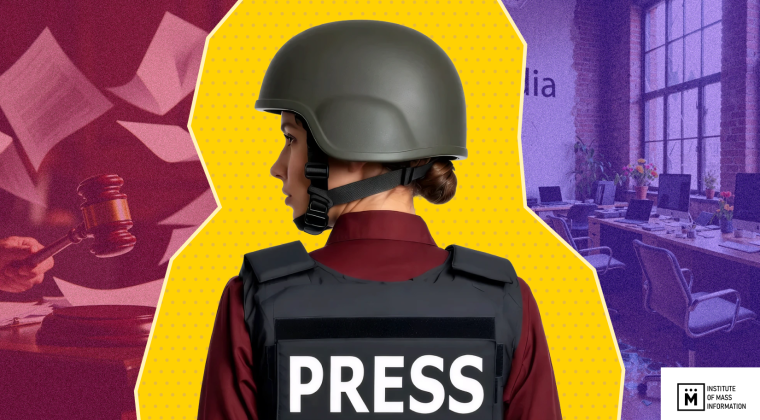The study is about work and life of journalists amid coronavirus lockdown (strain Covid-19) in Ukraine and worldwide, as well as the impact of the pandemic on mass media.
The purpose is to get more comprehensive and in depth understanding of nuances and realities of work of media professionals in Ukraine amid lockdown and to find solutions that can help journalists.
Justification of the research method. For this study, we decided to use a simple questionnaire-based survey. The questionnaires were filled in electronic form. Thus, all impacts were reduced to minimum. The questionnaire was anonymous and consisted of 18 questions. It took no more than 10 minutes to fill it in. Some questions had an answer option “I don’t want to answer” in order to comfort the most respondents.
Questionnaire developed and its results processed by: Iryna Zemlyana, media and security expert with IMI, marketing research manager (Certificate of Ukrainian Marketing Association No. COP 22/08-OMD).
Inputs: During six days in March (19-24) 2020, the e-mails were sent to journalists who are cited in the IMI newsletter database, or in journalistic groups on social networks. Local journalists from 20 regions of Ukraine were involved.
- General information
200 respondents took part in the survey.
Of these, 64.5% are women and 35.5% are men, 60% are journalists from all regions of Ukraine, and 40% are from Kyiv.
The most interviewed journalists work for online media.
The types of media that journalists work for
|
No |
Type of mass media |
% of journalists, |
|
1 |
Online mass media |
77% |
|
2 |
Printed press |
10% |
|
3 |
TV |
9% |
|
4 |
Radio |
4% |
The analysis of the types of journalistic activity revealed that the most interviewed are journalists (62%). The editors in chief are 11%, the editors and the correspondents account for 7%. The videographers and photographers make up 4%. And only 2% are anchorpersons. Other activities account for 7% of the total number of respondents.
78% of journalists work as full time staff of mass media outlets and have regular salaries, while the other 22% are short-time contractors and do not have a full-time job.
- Conditions of work of journalists in lockdown
65% of interrogated by IMI media professionals said that the media they work with started to function remotely, 8.5% said that the editions were functioning remotely only partially, 7% said that their media did not work remotely, 1% only were going to start working remotely. At the same time, 18.5% of journalists have to travel to fulfil their journalistic tasks.
75% of the editions the interviewed journalists work with did not provide them with any protection or antiseptics, 21% of the editions fully provide its staff with it, and another 3% do it partially and 1% of the editions were going to provide its staff with it in the near future.
At the time of the survey, 77% of media people had already experienced some negative effects of lockdown to professional activity. And only for 3% nothing has changed.
The effects of lockdown that journalists are already experiencing
|
Effects |
% of journalists |
|
|
1 |
Problems with earning payment (arrears and salary reduction) |
22% |
|
2 |
Increasing attention to stories |
20% |
|
3 |
Reduction / decrease of activity |
14% |
|
4 |
Reducing missions |
11% |
|
5 |
Lack of missions |
9% |
|
6 |
Refusal of missions |
8% |
|
7 |
Increase in missions |
4% |
|
8 |
Vacation at one’s own expense |
3% |
|
9 |
Increased workload |
3% |
|
10 |
Shut down of mass media edition |
1% |
|
11 |
Other |
2% |
|
12 |
No effects were felt |
3% |
The most interviewed media employees found that the effects of quarantine would increase the audience’s attention and increase the influence of the media ( 23% of respondents).
The expected effects of lockdown on mass media
|
No |
Expected lockdown effects |
% of journalists |
|
1 |
Increased audience attention to mass media and increased mass media influence |
23% |
|
2 |
Reformatting of one’s activity and search of new media solutions in online sphere |
22% |
|
3 |
Reduction / Arrears of salary |
18% |
|
4 |
Lack of missions |
10.5% |
|
5 |
Suspension of mass media without paying the salary |
6.5% |
|
6 |
Closing mass media |
5% |
|
7 |
Decrease audience’s attention and decrease mass media’s influence |
4% |
|
8 |
Dismissal |
4% |
|
9 |
Changing the activity |
3% |
|
10 |
Other |
2% |
|
11 |
No consequences are expected |
2% |
Due to lockdown, 81.5% of the respondents feel the need to improve their professional skills.
- The psychological condition of media professionals
The poll reveqled that 84% of journalists adhered to a regime of self-isolation and 12% do not. Only 4% don’t abode with lockdown and were not going to do it.
97.5% of the interviewed journalists were anxious about coronavirus lockdown. Of these, 14.5% had an intense anxiety, 60% had some moderate level of anxiety and 15% had feeble anxiety. Only 2.5% of Ukrainian journalists had no quarantine concerns.
92% of those surveyed experienced certain symptoms that might indicate some emotional distress.
List of symptoms experienced by interrogated media professionals amid lockdown
|
No |
Symptoms |
% of journalists |
|
1 |
Fatigue or anger |
18% |
|
2 |
Irritability |
14% |
|
3 |
Problems with concentration |
13% |
|
4 |
Sleep deficit |
9% |
|
5 |
Depression or despair |
7% |
|
6 |
Increasing physical pain in some parts of the body |
7% |
|
7 |
Constant over-eating or lack of appetite |
5% |
|
8 |
Feeling that you are getting it wrongly yourself and your surroundings |
4% |
|
9 |
You start to notice that you have started talking too slowly or too fast and moving |
3% |
|
10 |
Flashbacks or night terrors |
3% |
|
11 |
Drinking alcohol or drugs more frequently than usual |
3% |
|
12 |
Problems with your lover |
2% |
|
13 |
Thoughts that without you it would be better in the world, or about doing yourself harm |
1% |
|
14 |
I will not answer |
1% |
|
15 |
Others |
1% |
|
16 |
No effects were felt |
9% |
Asked if a psychotherapist’s help was needed, 11% said affirmatively, another 6% said they were visiting a psychotherapist. 83% said they did not need psychotherapy.
At present, 78.5% of interviewees did not have enough information from specialists with explanations of how the psyche reacted to the current situation.
- Gender
During quarantine, 46% of female journalists experienced an increase in workload at home. While only 22% of male journalists reported they had workload increased.
Workload distribution due to work from home
|
No |
Load |
% of women |
% of men |
|
1 |
It’s hard to plan a day and keep oneself respecting it |
40% |
46% |
|
2 |
Homework has increased |
18.5% |
16% |
|
3 |
We have more to cook for the family |
17% |
11,5% |
|
4 |
Feeling lonely |
14% |
5% |
|
5 |
We have to learn lessons, to entertain children |
8% |
11,5% |
|
6 |
Increased tension and anxiety in dealing with a partner / s |
2.5% |
10% |
Men were more likely to speak about anxiety and tension in their relationship with their partner / s.



